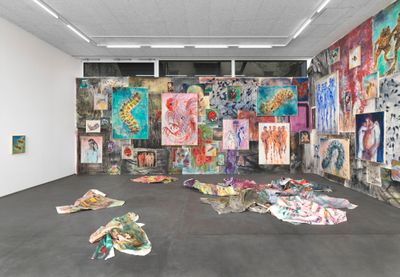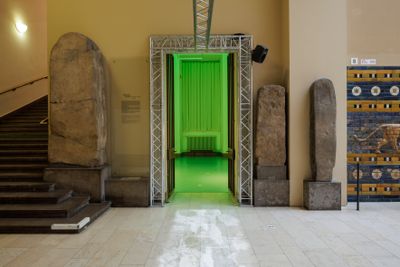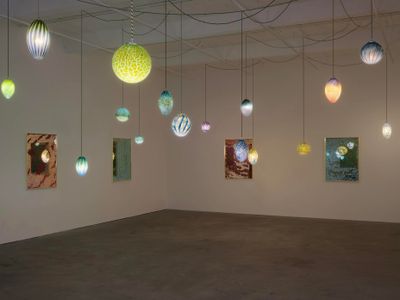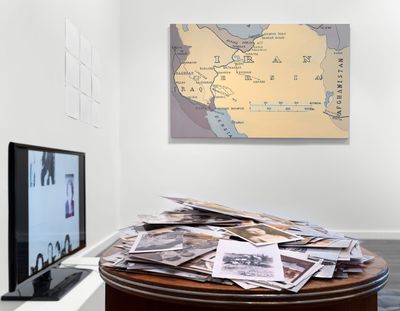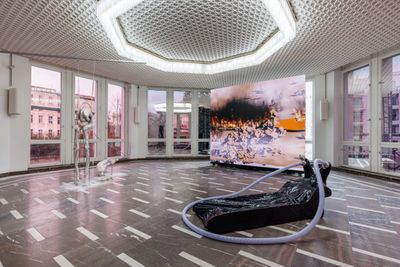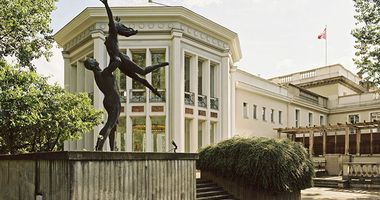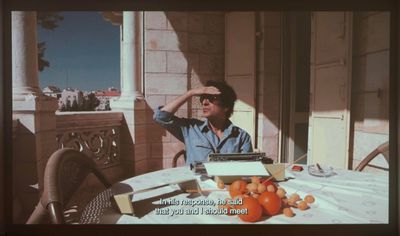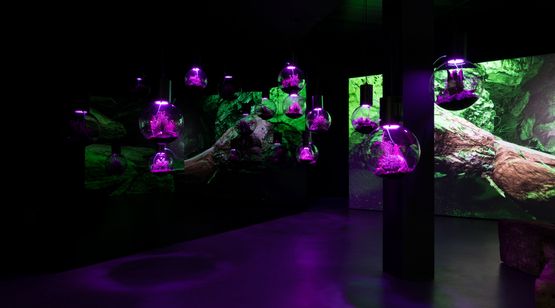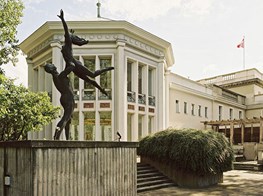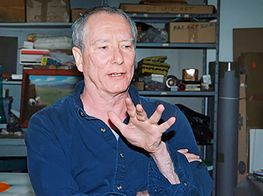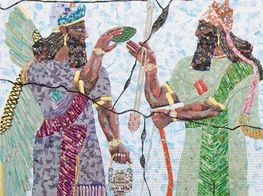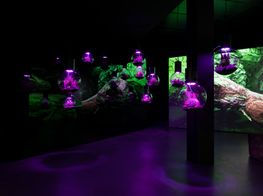Berlin Lowdown: Must-See Summer Exhibitions 2023
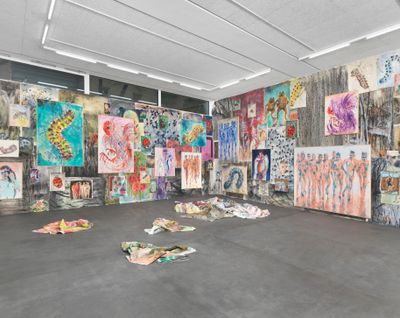
Exhibition view: Andrej Dúbravský, Anxiety of Subimago, Dittrich & Schlechtriem, Berlin (28 April–1 July 2023). Courtesy Dittrich & Schlechtriem.
Berlin bustled with visitors this April with more than 50 galleries opening exhibitions by emerging and established talent during Gallery Weekend Berlin. Having visited numerous exhibitions over the weekend, Ocula Magazine now shares those selected as must-see exhibitions for the summer months.
Andrej Dúbravský: Anxiety of Subimago
Dittrich & Schlechtriem, Linienstraße 23
28 April–1 July 2023
Expect: a multi-sensorial overload of masterfully crafted paintings populating the gallery space that juxtapose human and animal subjects.
Alluding to tensions between humankind and nature, Anxiety of Subimago sees the gallery filled with an installation of paintings by the Slovakian-born artist.
Large acrylic canvases completely cover two walls of the gallery over which smaller acrylic paintings on canvas are layered. More paintings on canvas are scattered in crumpled heaps on the grey gallery floor. Further gallery walls are left white, with one or two colourful paintings hung in contrasting elegance.
Painted in light, gestural brushstrokes, the bright canvases blend sexuality with nature. There are images of the human figure taken from screenshots of a gay porn commemorative commercial in which men run along a beach. Other paintings depict nature in various states of metamorphosis: pollinating bees, squirming tadpoles, bright red ladybugs, and bristling caterpillars.
The paintings reflect writer and curator Claire Koron Elat's accompanying exhibition essay, which describes the subimago as an intermediate step in the development of certain insects, between immaturity and maturity.
Dúbravský's paintings elevate traditionally crass subjects endowed with an ethereal quality, lending them the characteristics of otherworldly beings. He presents a blend of beauty and hopelessness, nature and sexuality, suggesting an anxiety-inducing disconnect between humans and nature relevant to our current ecological predicament.
Liam Gillick: Filtered Time
Pergamonmuseum, Bodestraße 1–3
6 April–15 October 2023
Expect: psychedelic projections of colour and light that enact, displace, and defamiliarise the usual Western fascination with ancient history.
In this first-time collaboration between Vorderasiatisches Museum, Pergamon and Hamburger Bahnhof – Nationalgalerie der Gegenwart, Liam Gillick conceives light, colour, and sound projections that draw attention to historic periods preserved within the museum.
Gillick's atmospheric projections conceive a trans-historical space that gathers ancient sculptures, wall reliefs, and remains of archaeological artefacts from Babylon's Ishtar Gate to monumental sculptures from the Tell Halaf archaeological site in Syria.
While light projections on the museum's ceilings are perhaps the least interesting parts of the exhibition, given enough time, the artist's animated colour fields projected onto ancient reliefs enliven historic works with dimension and life. The effect is akin to being under the influence of psychedelic substances, suggesting Western modernity's relationship with ancient history is a form of intellectual hallucination.
Hang Don't Cut
Kraupa-Tuskany Zeidler, Kohlfurter Street 41–43
28 April–29 July 2023
Expect: bright, melon-shaped lamps and painted mirrors that collectively explore writing and knowledge transmission in Central Asia.
Slavs and Tatars look to Central Asia with new sculptures shown alongside works by the collective's previous collaborators.
On view are melon-shaped, glass-blown lamps—a play on the etymology of 'melon' in Slavic, which goes back to the verb 'to blow' and engages with an Uzbek legend that sees the fruit as divine gifts containing messages on their surface patterns, which resemble Arabic scripture.
These lamps hang from the gallery ceiling at different heights, each representing a melon species from Central Asia with a focus on Uzbekistan and Xinjiang. On the walls, mirrors and reverse glass painted with acrylic melon textures conceal digital captchas within their patterns.
A Middle Eastern gate made of white carpet with black outlines, Sanft Power (2022), leads to the exhibition's second part, featuring painting, sculpture, and installation by the collective's former collaborators: Andrey Anro, Dozie Kanu, Mina Masoumi, and Lin May Saeed.
Simurgh. Ten Women Artists from Iran
Crone Berlin, Fasanenstraße 29
28 April–17 June 2023
Expect: ten artists combining politics and poetics to address the multiple perspectives involved in the struggle of Iranian women.
Curated by Başak Şenova, the exhibition featuring works of varying mediums by women artists explores the legend of Simurgh, a mythological bird from Persian traditions, as an allegory for the struggles of Iranians both in Iran and abroad.
Artists Soheila Sokhanvari, Yalda Afsah, Ramesch Daha, Nooshin Farhid, Parastou Forouhar, Mona Kasra, Neda Saeedi, Anahita Razmi, Farkhondeh Shahroudi, and Mehraneh Atashi, address topics from memory to surveillance, identity politics, economics, and social change.
Farkhondeh Shahroudi's spherical sculptures made of carpet and rubber (Flying Carpets, 2018) and Mehraneh Atashi's video animation featuring trees with eyes around their bark (They Become My Eyes on Your Body, 2018) are some of the notable works exploring domestic ideals in Arabic and Persian mythology and states of surveillance, respectively.
The decisive highlight, however, was Anahita Razmi's No National Flag Uses a Gradient #1 – #8 (2022), a suite of eight gradated black-and-white flags adorned with the phrase 'No National Flag Uses A Gradient'.
Human Is
Schinkel Pavillon, Oberwallstrasse 32
19 March–23 July 2023
Expect: a conceptual bridge between the Industrial Revolution's gothic imaginaries and humanity's re-making in the age of artificial intelligence.
Starting from science fiction, Human Is is set up as a visceral laboratory to disambiguate the significance of being human, refracting its meaning through 31 historical and contemporary works by artists, writers, and filmmakers across centuries.
Notable works include Ian Cheng's Emissary Sunsets The Self (2017) in the main gallery upstairs, one of Cheng's signature generative videos that explores humanity's cognitive evolution, set within a volcanic landscape that shifts with time.
David Cronenberg's Instruments for operating on mutant women consists of props from his film Dead Ringers (1988), while Mike Kelley's Kandor 5 (2007) comprises a mixed-media sculpture on a illuminated base with video and sound, named Superman's birth planet.
Other notable participants are the late Austrian director Fritz Lang with a print from his film Metropolis (1927) and horror writer Mary Shelley, whose Frankenstein (1818) placed near the entrance of the main gallery provides historical context for the exhibition.
Michael Rakowitz: I'm good at love, I'm good at hate, it's in between I freeze
Barbara Wien, Schöneberger Ufer 65, F3
28 April–29 July 2023
Expect: a bold deployment of the artist's Arab-Jewish identity to set a different historical record through film, even if only for the sake of archives.
Michael Rakowitz's third solo exhibition with Barbara Wien revisits the artist's ongoing interest in Canadian singer-songwriter and poet Leonard Cohen. Starting from a boycotted concert, it contends with the fraught entanglements between art and geopolitics.
The exhibition centres on Rakowitz's film in the main gallery produced as a letter to Cohen. The film, I'm good at love, I'm good at hate, it's in between I freeze (2009–2023), delves into Cohen's complex relationship with the Jewish homeland, exploring the historical context and aftermath of a concert in Ramallah, Palestine, that never happened.
Considering the pressures that have been exerted on the film since its initial production, Rakowitz invited colleagues to speak about the estate's withdrawal of Cohen's songs. A muted scene which shows Rakowitz on stage performing a Cohen song carries the voice-over of artist Emily Jacir reciting the words of the late Palestinian scholar Edward Said.
The adapted version of the film is accompanied by an installation of documents, books, photographs, and memorabilia connected to the project, including Cohen's typewriter and a facsimile of the letter Rakowitz wrote to the singer.
A separate presentation in the gallery's ground floor showroom displays works from Rakowitz's series 'The invisible enemy should not exist' (2007–ongoing). The project consists of full-size paper mâché reappearances of artefacts from the National Museum of Iraq in Baghdad that were destroyed or looted during the 2003 U.S.-led invasion, or from archaeological sites and museums sacked by ISIS in the aftermath of the war.
Now closed, but of note during Gallery Weekend Berlin:
Hito Steyerl: Contemporary Cave Art
Esther Schipper, Potsdamer Street 81E
28 April–25 May 2023
A beautiful blend of the natural and synthetic that triggered viewers' imaginations about animal instincts playing out in the social landscape.
Re-adapted inside a cave-like space at the gallery, Hito Steyerl's immersive environment Animal Spirits was first featured in the artist's solo exhibition A Sea of Data at Seoul's National Museum of Modern and Contemporary Art in 2022.
The artist later pulled the work from documenta fifteen (2022) after a controversy around the organisers' handling of antisemitic tropes in one of the public murals displayed.
Engaging with the concept of an animal spirit, Steyerl's adapted work consists of a sensory environment of LED-lit plants suspended from the ceiling, AI-generated projections of cave paintings, and a single-channel film exploring post-pandemic cultural production.
Inside the cavernous space, purple-lit plants inside spherical glass containers are placed in soil and suspended from the ceiling, overseen by LED growth lamps. These glass spheres also contain sensors that measure plant health and react to visitors in the gallery. The data they gather triggers a glittering cloud of particles that appears to travel through the exhibition space.
The main film, Animal Spirits, which takes its title from economist John Maynard Keynes' term describing how people make financial decisions in uncertain times, combines scenes shot with actor Mark Waschke impersonating Keynes, with historical film footage, animation, motion graphics, and interviews the artist conducted with shepherds in Northern Spain and fellow artists.
In the video, Steyerl boldly interrogates consumer behaviour through her signature style of critical humour dealing with digital technology's economic and ideological consequences. In this case, the blockchain and metaverse. —[O]

